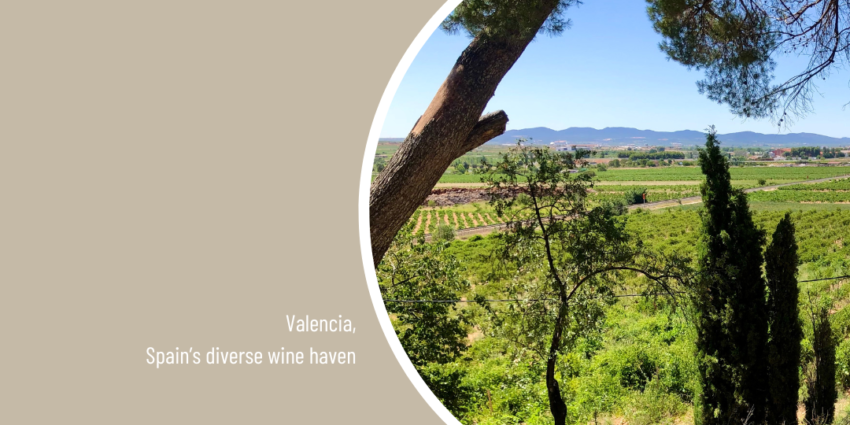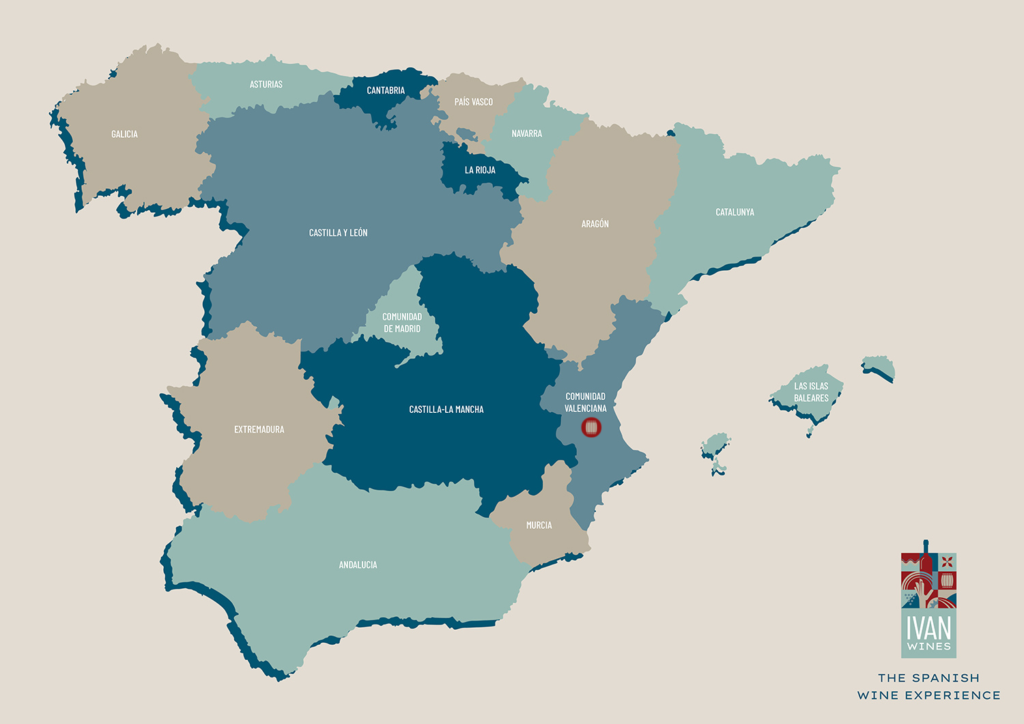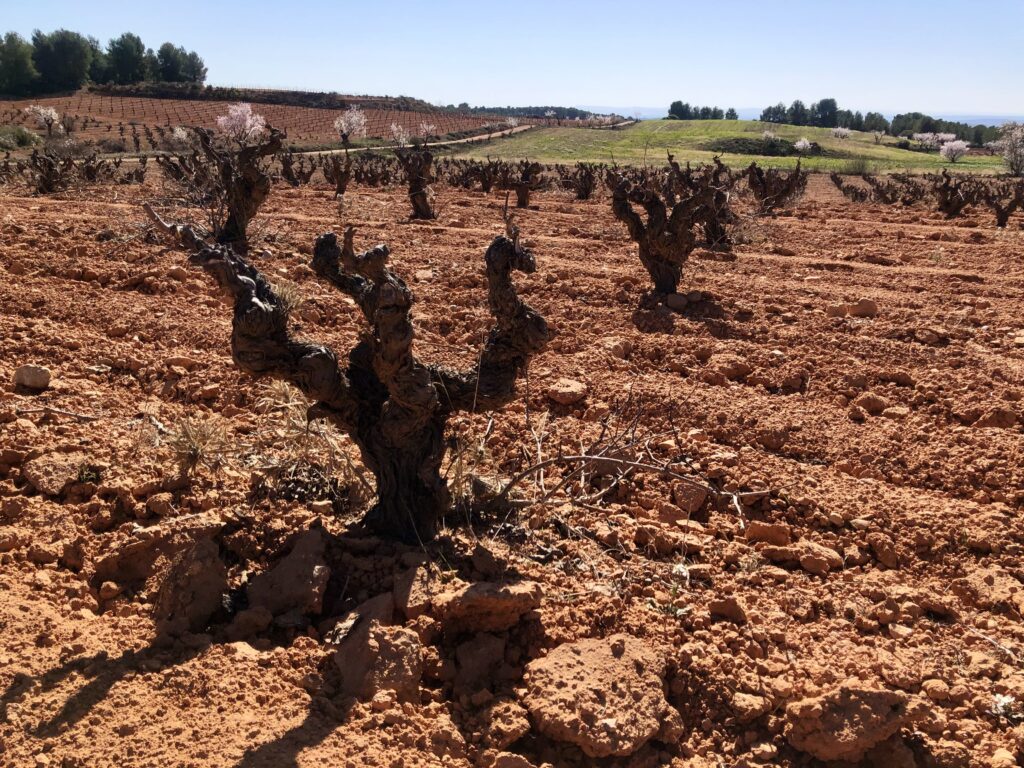Valencia, Spain’s diverse wine haven

Based in Valencia, I regularly head out to get to know the wine regions of Spain. Travelling through the ever-changing landscape in this vast country, past ancient cities and small old villages gives me a great sense of freedom. Unbelievable how varied Spain is! In this blog I stay close to home as we will look into the beautiful Valencia region.
The Communidad Valenciana in a nutshell
Valencia sits along Spain’s eastern Mediterranean coast, a sunny region blessed with an ideal climate for viticulture. The autonomous community combines the vibrant coastal city of Valencia with mountainous inland terrain, creating diverse microclimates perfect for winemaking. Beyond its famous oranges and paella, Valencia has a rich winemaking tradition dating back to Roman times. With over 55,000 hectares of vineyards across three distinct Denominations of Origin, the region produces everything from aromatic whites to full-bodied reds and the local specialty—sweet dessert wines. The Mediterranean influence gives Valencia a unique character, where centuries-old winemaking traditions blend seamlessly with modern innovation.

The Valencian wine regions
Valencia’s wine country spans from the Mediterranean coast to elevations of over 900 meters in the interior, creating remarkable diversity across its three DOs: Utiel-Requena, Valencia, and Alicante. The region benefits from a Mediterranean climate moderated by altitude in the inland areas, with hot, dry summers and mild winters. Unlike Spain’s more famous wine regions, Valencia remains somewhat of a hidden gem, offering exceptional value and distinctive character.
Within DO Valencia lies a particularly special subregion—Fontanars dels Alforins, often called “the Tuscany of Valencia.” This picturesque valley, situated at around 600-700 meters above sea level, features gently rolling hills covered with vineyards, olive groves, and almond trees that create a landscape remarkably reminiscent of central Italy. Boutique wineries here focus on quality over quantity, creating sophisticated wines that have gained international recognition and helped elevate the reputation of the entire Valencia DO.
The Valencian Community is also home to five prestigious Vino de Pago estates—El Terrerazo, Pago de Tharsys and Pago Vera de Estenas, plus Los Balagueses and Chozas Carrascal, all in the Utiel Requena region. A Vino de Pago is a classification in Spanish wine law, representing specific vineyards with unique terroir characteristics that have earned the right to their own appellation status.
The region has been shaped by visionary winemakers who have helped put Valencia on the world wine map. Toni Sarrión of Bodega Mustiguillo has pioneered the revival of the Bobal grape, earning international acclaim and helping establish El Terrerazo as the region’s first Vino de Pago. Pablo Calatayud of Celler del Roure has become renowned for rediscovering ancient winemaking techniques, aging wines in clay amphorae and working with forgotten local varieties in the Clariano subzone in DO Valencia. Meanwhile, Pepe Mendoza has revolutionized winemaking in Alicante, crafting Mediterranean-inspired wines that showcase native varieties with a modern approach that respects tradition.
The soils across the broader region are quite varied —from limestone and clay in Utiel-Requena to sandy coastal soils in parts of DO Valencia. While international varieties like Cabernet Sauvignon and Chardonnay have gained ground, the region champions indigenous grapes. The red Bobal grape dominates Utiel-Requena, while Monastrell thrives in Alicante. For whites, Merseguera and Moscatel are important, particularly in DO Valencia. In addition, small quantities of interesting lesser known grapes such as Verdil, Tardana (white) and Mandó and Bonicaire (red) can be found.
This is Mediterranean Spain at its most authentic—less touristed than some of the other wine regions but offering a wealth of cultural and oenological experiences such the ones that can be found in Requena.
Requena, a historic wine town
The ancient town of Requena sits at the heart of the Utiel-Requena DO, about 70 kilometers inland from Valencia city at an elevation of around 700 meters. This historic settlement has been intertwined with viticulture since Roman times, but it was during the medieval Moorish period that the underground wine caves were carved beneath the town. Today, these fascinating “cuevas” form a subterranean network that you can explore, offering insight into centuries of winemaking history.
Requena’s historic center, known as La Villa, features well-preserved medieval architecture including the Castle, the Gothic Church of Santa María, and the Wine Museum housed in a 15th-century palace. Every August, the town celebrates its wine heritage with the Feria y Fiesta de la Vendimia, an old harvest festival dating back to 1948.
The surrounding countryside is dominated by vineyards of Bobal, the thick-skinned native grape that accounts for over 70% of plantings in Utiel-Requena. Once used primarily for bulk production, careful viticulture and modern winemaking techniques have transformed Bobal into the source of an exciting red wine that invites you to a further discovery —deeply colored, with vibrant acidity and rustic charm. See here my article why you should try a Bobal wine.
When you visit Requena you will discover a town where wine isn’t just an industry but a way of life. The landscape of waving vineyards, ancient olive trees and small villages, offers spectacular views especially beautiful during autumn when the vines turn golden and crimson.

Wine & food of the region
Valencia’s three DOs each bring something distinctive to the table. The region’s cuisine perfectly complements its wines. Along the coast, Valencia’s seafood-based dishes like paella de marisco pair beautifully with local whites and rosados. The traditional Valencian paella with rabbit and chicken finds its match in the medium-bodied reds from DO Valencia. In the interior, heartier food dominates—try the local embutidos (cured meats) with a powerful Bobal from Utiel-Requena.
No discussion of Valencia’s gastronomy would be complete without mentioning the sweet wines. The Moscatel dessert wines from DO Valencia and the historic Fondillón from Alicante are perfect companions to regional desserts like arnadí (pumpkin and almond sweet) or the almond-based turrón that originated in Alicante.
For the culinary explorer, Valencia offers a large diversity within a relatively compact region. From beachside chiringuitos serving fresh seafood to rustic mountain restaurants specializing in game and traditional stews, the food scene mirrors the wine landscape—varied, authentic, and deeply connected to the land. Check out the local wine and food pairings that have evolved together over centuries, creating harmonies reflecting the essence of this lovely Mediterranean region.
Location
Recommended sites
Wine Tourism in Communidad Valenciana
Do you want more?
Want to read more? Keep an eye on my website and social channels. To subscribe to my newsletter, click the button on this page.
Spain is home to many beautiful, but also lesser-known quality wines. With Ivan Wines, I focus on discovering and promoting these wines, the makers and the regions. I am a Dutch Registered Vinologist, Spanish Wine Scholar and WSET Level 3 Wines Certified, and I organize tastings and wine tours from Valencia.


